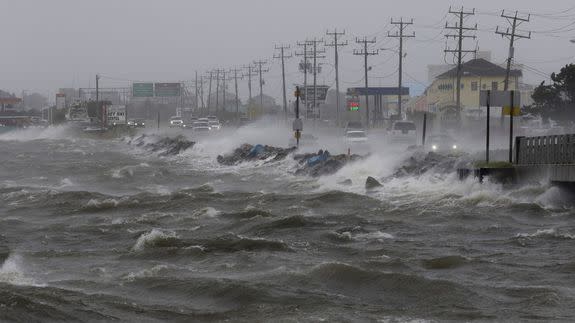Sea level rise is worsening Hermine's coastal flooding

Post-Tropical Storm Hermine is poised to deliver the Mid-Atlantic states a fierce blow, with days of strong winds, pounding waves and storm surge-related coastal flooding.
Yet while the path of Hermine and height of its surge gets most of the attention, there's a hidden, human-caused and long-term factor at work here too: Sea level rise is making all coastal flooding events in the Mid-Atlantic region more frequent and worse.
Globally, sea levels are rising at the fastest rate of any time in at least the past 2,800 years, according to a study published in February. This is due to warming ocean waters, which cause the sea to expand, and the melting of polar ice caps.
SEE ALSO: A lengthening crack is threatening to cause an Antarctic ice shelf to collapse
The Mid-Atlantic happens to be located in a so-called sea level rise "hotspot," meaning that seas are rising faster there — and are predicted to continue doing so — than they are in other parts of the U.S., and indeed other areas of the globe.
The hotspot is due to a combination of things which include land subsidence, involving the slow settling of land over time, as well as ocean currents like the Gulf Stream.

Image: APTom Copeland/AP
The end result is a sharp uptick in "nuisance" coastal flooding events, which often take place even on sunny days, from Virginia to Massachusetts. The hotspot also boosts the flood potential from major storms, including Hermine.
For example, a report published in February from the nonprofit research and journalism group Climate Central found a startling increase in nuisance flooding events in recent decades.
For the Climate Central analysis, researchers took hourly water level records from 27 different tide gauges at U.S. coastal locations, and removed the human-caused component in global sea level from them.
This resulted in a history of what water levels should have been absent any global warming-related sea level rise.
The group found that out of 8,726 days when unaltered water level observations exceeded National Weather Service local “nuisance” flood thresholds for minor impacts, such as flooding of coastal roads, 5,809 days would not have exceeded those thresholds if the global warming component of sea level rise were removed.
In other words, about two-thirds of the 8,726 total flood days identified in the report could be said to be human-caused due to climate change.
For example, in Annapolis, Maryland, the study found that the number of nuisance flood days have increased from 193 to 701 days between the first half of the 1951 to 2014 period and the second half.
That works out to an increase of 508 nuisance flood days. The study found that about 394, or nearly 78 percent, of these flood days would not have occurred if it weren't for global warming-related sea level rise.
While that nuisance flooding is increasing, major storms are hitting that ordinarily would be damaging, but in the new era of higher sea levels can be even more deadly.
This is where Hermine comes in.
Hermine is far more than a nuisance flood
The National Hurricane Center warned Saturday that Post-Tropical Storm Hermine could bring "life-threatening" storm surge inundation (meaning water on top of land that would normally be dry ground at the time of high tide) that could reach a maximum of 3 to 5 feet from Chincoteague, Virginia to Sandy Hook, New Jersey. This includes the entirety of the Delaware, Maryland and New Jersey coastlines.
The agency is also forecasting at least 2 to 4 feet of inundation from Sandy Hook north to Bridgeport, Connecticut, including the New York City metro area.
Storm surge is caused by a storm's low pressure and strong winds that pile water toward the coastline, causing water levels to rise, usually reaching a peak around the time of high tide.

Image: NCAR
Due to sea level rise, this storm surge is riding atop a higher background level of water, meaning that it is easier to flood the coastline today than it was before human-caused sea level rise became so apparent.
Some sea level rise experts compare this factor to a basketball player being able to make more dunks when he or she jumps from a rising basketball court.
When Hurricane Sandy hit in 2012, for example, the sea level at the Battery in lower Manhattan was about 11 inches higher than it was in 1900, which meant that the total inundation from the storm was worse than it would have been had the storm hit a century earlier.
The same will be true for Hermine, and every other storm to come, as the floor that storm surge's are riding on top of continues to rise.

